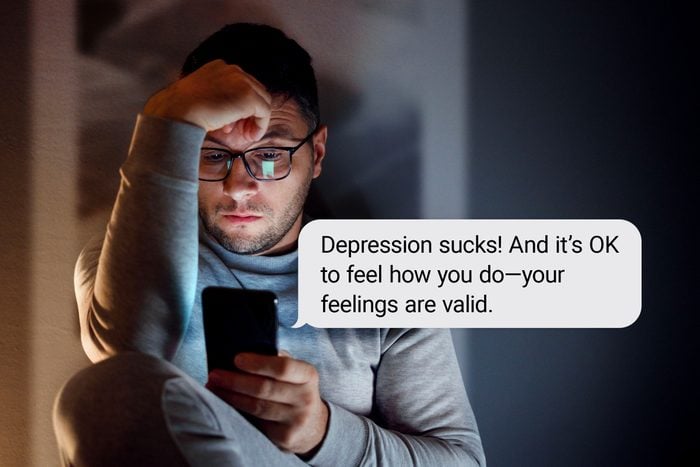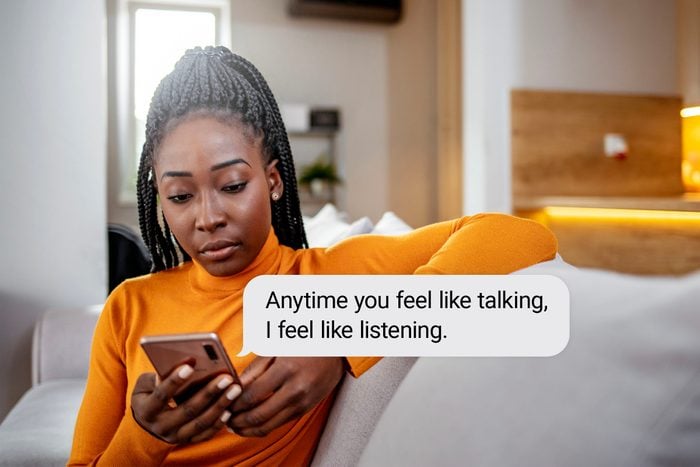Posts Tagged anxiety
[WEB] 14 Perfectly Worded Texts to Send Someone with Depression
Posted by Kostas Pantremenos in Depression on January 18, 2024
Not sure what to say when someone is depressed? These little texts can make a big impact.

Texts are an excellent way to reach out
One in three people in the United States will struggle with depression at some point during their life, and one in eight will have a major depressive episode. It can be hard to know what to say when someone is depressed, so it’s a good idea to have some strategies in place now to support loved ones during a dark time.
“Texting is an easy way to show someone you are thinking about them and you care,” says Fran Walfish, PsyD, a relationship therapist in Beverly Hills. “The very nature of texting makes it ideal because they don’t have to feel pressure to answer in the moment if they’re not feeling up to it, like they would if you called or asked them in person.”
While a text doesn’t replace in-person interactions or phone calls, notes Walfish, they can be one great tool to provide support.
What you shouldn’t say to someone living with depression
When texting or talking with someone about depression or any mental illness, it’s important to follow a few etiquette rules and avoid some common pitfalls, says psychiatrist and neuroscientist Dave Rabin, MD, PhD, co-founder of Apollo Neuroscience. Even folks who are trying to be kind and loving can easily make these mistakes:
- Offering unsolicited advice. (“Have you tried yoga?”)
- Minimizing their feelings. (“Everyone feels down sometimes—it’s not a big deal.”)
- Being forcefully positive. (“Every cloud has a silver lining! Count your blessings!”)
In fact, some of the “polite” ways you’re probably talking about mental health are actually rude, and that’s not limited to comments about depression.
What to say when someone is depressed
“Depending on their personality, you could text something funny, like a meme about depression, an uplifting quote or a ‘thinking of you’ message,” Walfish says. “Even a simple ‘Hey, just wanted to let you know I love you! How are you feeling today?’ is always great.”
Whatever you choose, focus on listening to their experience, validating their feelings and providing support. The short texts below, provided by Dr. Rabin and Walfish, can open up the lines of communication and let a person living with depression know they aren’t alone.
Get Reader‘s Digest’s Read Up newsletter for more etiquette, humor, cleaning, travel, tech and fun facts all week long.

RD.COM, GETTY IMAGES (2)
“Hey, friend! Just thinking about you and wanted to check in. How are you doing?”
One of the most powerful ways to help someone with depression is simply letting them know that you haven’t forgotten about them. “This simple message expresses concern and opens the door to further conversation if they’re feeling up for it,” says Walfish. This is something good friends do.
Pitfalls to avoid: Don’t press for information, says Walfish. Instead, keep your interaction low-pressure. There’s a solid chance that they will reply with something like “Fine” or “Good,” and that’s OK. You can ask one follow-up question, but avoid texting back comments that can come across as accusatory, like: “Are you sure?” or “I don’t believe you.”

RD.COM, GETTY IMAGES (2)
“I want you to know that I’m here for you and I want to help.”
One big issue that many people with mental illness struggle with is feeling like they’re a burden to their loved ones, Dr. Rabin says. This short-and-sweet text offering your support is a good thing to say when someone is depressed because it lets them know that helping isn’t a burden but something you want to do.
Pitfalls to avoid: Skip any version of “Let me know how I can help.” This is one of the top mistakes people make when speaking to people with a chronic illness. It puts the burden of thinking of something back on them, and it can feel like too much. Instead, have a couple options ready to offer—perhaps giving them a ride somewhere, bringing them a treat or watching a show online together.

RD.COM, GETTY IMAGES (2)
“Depression sucks! And it’s OK to feel how you do—your feelings are valid and understandable.”
Validating someone else’s feelings and experiences is one of the most underrated things you can do to help someone with depression, Walfish says. “People may worry that they are going crazy,” she explains, “and letting them know what they are experiencing is understandable is powerful.”
Pitfalls to avoid: Don’t say “I know exactly how you feel” or tell them how they are feeling. Instead, ask them open-ended questions and let them tell you how they’re feeling. For example, let’s say they tell you something like: “I’m feeling so sad, and I’m worried I’ll never get out of this.” Reflect it back to them using their words, which is one of the therapist secrets that pro counselors use. For instance, “I hear you saying that you’re worried this will never end and you’ll be stuck in this sad place forever.” You’re showing them that you’re listening and sympathizing with them, which will help them feel more comfortable to continue opening up about their experience.

RD.COM, GETTY IMAGES (2)
“Anytime you feel like talking, I feel like listening.”
Simply offering a nonjudgmental listening ear can provide a surprising amount of relief to people with depression, Dr. Rabin says. People can benefit from processing their feelings verbally, and they just need you to listen in a loving way.
Pitfalls to avoid: Don’t try to be their therapist, Dr. Rabin says. You don’t need to provide advice, and this isn’t the time to share your own experiences (unless they ask). Focus on being an attentive listener by making affirming noises and comments and having open body language if you’re speaking in person. And if you do make a mistake? It’s not the end of the world—here’s how to apologize.

RD.COM, GETTY IMAGES (2)
“Want to go for a walk or meet up for coffee?”
It’s a good idea to offer to meet up, and even better when they take you up on it. When you spend time together, you can reinforce your love and concern while giving them an opportunity to talk about their depression if they’d like or to talk about something else if they’d prefer to take their mind off it, Walfish says. Give them one or two low-stakes options to meet up (think: something familiar and close to home, like meeting up at a park or grabbing dessert), and then let them choose. Don’t overwhelm them with choices—two is plenty—as many people with depression suffer from “decision fatigue,” or the inability to make even seemingly simple decisions.
Pitfalls to avoid: Keep the emphasis on your relationship and away from “saving” them. There’s a big difference between “If you go for a walk every day, it will help your depression” (which is true but is unsolicited advice and therefore unlikely to be helpful) and “I’d love to go for a walk with you” (which focuses on your relationship and desire to be with them). Depending on the situation and the person, you may want to learn how to set boundaries so you don’t end up feeling burned out.

RD.COM, GETTY IMAGES (2)
“Just want to let you know I think you’re pretty great, and I’m glad we’re friends/family!”
People who are living with depression are often harshly self-critical, and reminding them what you love about them is powerful, Dr. Rabin says. You don’t have to get overly effusive, and that may actually get their guard up, so stick to just one compliment.
Pitfalls to avoid: Don’t get sucked into an argument. If they reply, “I’m really not great at all,” don’t respond with: “Well, I think you are!” Instead, answer with an invitation: “It sounds like you’re feeling really down about yourself right now. Want to talk about it?”

RD.COM, GETTY IMAGES (2)
“You’re not alone—I’m with you in spirit!”
“Feeling alone and isolated is both a symptom and cause of depression, creating a vicious cycle of loneliness and mental illness,” Dr. Rabin says. This text can change that narrative. And if you add in a picture of the two of you together, the combo will likely bring a smile to their face.
Pitfalls to avoid: Be sure to back up your words with actions. If you don’t live nearby, check in with them regularly via phone, video chat and/or text. If you are close, stop by for a visit or invite them to do something. Simply saying “You’re not alone” isn’t going to help if they really are all alone.

RD.COM, GETTY IMAGES (2)
“How are you feeling today?”
Depression can be constant, but it often waxes and wanes in severity. And it can be hard to tell how bad someone is feeling at that moment, as many sufferers have gotten good at hiding or masking their sadness, Walfish notes. Sending this text asking them a direct question shows that you are interested in not just how they are doing overall but how they are feeling right then.
Pitfalls to avoid: Don’t fill in their feelings for them or imply any judgment of those feelings. For instance, skip anything like: “I haven’t heard from you for a while, so I’m guessing you’re feeling pretty sad. But I want you to be happy!” Saying this risks getting it wrong and hurting their feelings or making them feel like their emotions are “wrong.”

RD.COM, GETTY IMAGES (2)
“Can I call you tomorrow and check in?”
Let your loved one know that you’re not just checking in once—you plan to check in regularly with them in the future. This gives them something to look forward to and relieves them of the burden of asking for more care, Dr. Rabin says. But it still leaves them in control with a way out if they don’t feel like chatting.
Pitfalls to avoid: Don’t take it personally if they say no. You aren’t responsible for them or their feelings, and they may not want you (or anyone) to check up on them. That can sting, but recognize it’s really not about you, Dr. Rabin says.

RD.COM, GETTY IMAGES (2)
“I may not understand what you’re going through, but I want to be here for you.”
Showing sympathy and empathy are two of the fundamental ways we relate to other people. Acknowledging that you don’t have the same lived experiences that they do but care about what they are experiencing is a kind way to open a discussion. Everyone struggles with something, explains Dr. Rabin, and can relate on a basic level while still noting the uniqueness of that person’s experience. This also works well in a handwritten note that accompanies a small gift, like a flower delivery.
Pitfalls to avoid: Don’t say “I know what you’re going through.” The truth is, you don’t. Even if you have had or currently have depression, your experience will not be the same as your loved one’s, and making assumptions about their feelings based on your own can feel hurtful and invalidating, Dr. Rabin says.

RD.COM, GETTY IMAGES (2)
“I’m so sorry you are hurting, my friend.”
This simple text is great for people who don’t know what to say but want to say something, Walfish says. Acknowledging their suffering validates their feelings, and expressing your sorrow that they are hurting lets them know they are seen and heard.
Pitfalls to avoid: Don’t make it about you. That means you shouldn’t say anything like: “I hate to see you hurting” or “It hurts me when you hurt.” Keep the focus on them, advises Walfish, and don’t make them responsible for your feelings.

RD.COM, GETTY IMAGES (2)
“Saw this and thought you might get a kick out of it.”
The internet is full of silly GIFs, funny memes, dark humor and strength quotes. “If you see something that your loved one would enjoy, take a minute and text it to them—no words necessary,” Walfish says. They’ll know you’re thinking of them and will get a chuckle or little boost of positive energy in their day.
Pitfalls to avoid: Know your loved one and their sense of humor before sending anything risqué or overly dark. Keep quotes appropriate to their personality and situation, and also avoid sending things that feel too general or minimize their feelings.

RD.COM, GETTY IMAGES (2)
“I imagine today may be tough. How are you feeling?”
Some people have generalized depression that persists over a long time, but others may go through a depressive episode triggered by an event—like the death of a child or a painful anniversary, Walfish says. Remembering the tough day and reaching out to offer extra love and support shows you care and are mindful of what they’re going through. And, depending on the situation, this text can offer comfort.
Pitfalls to avoid: Don’t assume you know how they feel about it. They may indeed be feeling upset, but they may also feel calm or resolute. It’s best to just ask them how they feel and then reflect that back to them.

RD.COM, GETTY IMAGES (2)
“I don’t know what to say except I love you.”
There are times when someone else’s feelings may feel so immense or out of your own experience that you don’t have any idea what to say. “It’s OK to be honest and admit that,” Dr. Rabin says. “No one expects you to have all the answers. And saying anything is usually better than saying nothing.”
Pitfalls to avoid: People who don’t know what to say when someone is depressed often are tempted to use platitudes like: “Don’t worry, everything happens for a reason,” “The sun will come out tomorrow” or “You’ll get through this.” These sayings can feel trite and minimize their experiences. In fact, some of the “polite” things you may be saying to them and others are not as polite as you think they are.
About the experts
- Dave Rabin, MD, PhD, is a psychiatrist, neuroscientist and co-founder of Apollo Neuroscience, wearable technology that uses touch therapy to combat stress and promote resilience and recovery. He specializes in the treatment of PTSD, depression, anxiety disorders and substance-use disorders.
- Fran Walfish, PsyD, is a relationship therapist and author in Beverly Hills.
Source:
- National Institutes of Mental Health: “Statistics”
[WEB] Changes in Emotion After Traumatic Brain Injury – Factsheets
Posted by Kostas Pantremenos in TBI on January 16, 2024
What causes emotional changes after TBI?
How to address emotional concerns after TBI
Family members can help by changing the way they react to emotional distress after TBI:
Peer support and other resources

The way people experience or express emotions may change after a traumatic brain injury (TBI). While this can be distressing for family members and friends, many strategies can help manage these emotional concerns after TBI.
Anxiety
Anxiety is common in the general population and in people with moderate to severe TBI. Anxiety may look different from person to person, but most people with anxiety have intense fear and worry. Some people also have physical signs of anxiety. For example, they may have a racing heart, rapid breathing, sweating, shaking, or the sensation of butterflies in their stomach. They may feel anxious, stressed, or overwhelmed without knowing why. This stress can make recovery after a TBI even more difficult. People with TBI may have anxiety in situations that did not bother them in the past. They may feel anxious being in a crowd, when they are being rushed, or when adjusting to sudden changes in plans. They may feel overwhelmed in situations that require a lot of attention, fast thinking, or processing a lot of information at the same time.
Depression
People with depression may feel sad, irritable, or worthless. They may feel tired much of the time and may experience changes in sleep or appetite or difficulty concentrating. Sometimes, people may even have thoughts of death, hurting themselves, or taking their own life. People with these feelings often withdraw from others and lose interest in or feel less pleasure from activities they used to enjoy. Many signs of depression, such as fatigue and frustration, are also signs of TBI. However, someone with a TBI may experience these symptoms but not be depressed. Sadness, and grief are common after brain injury. Some people feel depressed right after TBI, but these feelings may also appear during the later stages of recovery. Symptoms of anxiety may appear before depression. If these feelings become overwhelming or interfere with recovery, the person with TBI may be experiencing depression.
What causes emotional changes after TBI?
- Emotional changes can occur if the TBI affects areas of the brain that control emotions. Changes to these brain regions and to the chemicals that help the brain work can affect how the person with TBI experiences or expresses emotion.
- People with TBI may have a hard time coping with their injury. They may need to adjust to a loss of independence, or to changes to their role in their family and in society. These changes can lead to frustration and dissatisfaction with their life.
- People with TBI may also have changes in their thinking abilities, such as memory, attention, speed of thinking, and reasoning. These changes can cause them to feel overwhelmed if they can’t remember things or keep up with what others are doing or saying. They may respond emotionally, with sadness, worry, or anger.
- Use of alcohol or other drugs can lead to emotional changes, and emotional distress may also lead to alcohol and drug use.
- People who had problems with depression or anxiety before the TBI may find that these problems are worse after the TBI. They may feel isolated, depressed, or misunderstood which can also affect emotions.
How to address emotional concerns after TBI
- Remember that emotional distress is not a sign of weakness and it is no one’s fault. A person can’t get over their distress by wishing it away or “toughening up.”
- Medicine and counseling or psychotherapy can help with emotional distress after TBI. Sometimes, a combination of both works best.
- If you choose to take medicine, you should work closely with the doctor or provider who prescribed the medication. Be sure to attend all follow-up visits about your medicine.
- If you choose counseling or psychotherapy, let your therapist know about your TBI. Ask them to help you write important concepts down so that you can review them at home. Tell your therapist if you need to have something repeated in order to understand it better.
- Stress and stressful situations can trigger emotional distress. People with TBI can take steps to reduce stress. For example, they can use relaxation techniques such as deep breathing or muscle relaxation, schedule breaks, and practice mindfulness activities.
- A daily schedule of structured activities and exercise can help reduce distress. Activities may include exercise, puzzles, or games.
- It is best to get treatment early to avoid needless suffering. Do not wait.
- If you (or your family member) have thoughts of suicide, get help. You can call a local crisis line, 911, or the National Suicide Prevention Lifeline at 1-800-273-TALK (8255), or go to your local emergency room.
Family members can help by changing the way they react to emotional distress after TBI:
- Remember that anxiety, depression, irritability, and other changes in emotion after TBI may be due to brain injury. Try not to take it personally. Also remember that changes in emotion are no one’s fault and try not to blame the person with TBI.
- Stay calm and try not to react in an emotional way yourself or to argue with the person with TBI. If you are angry or hurt, take a break before you talk to them.
- When they are acting out in anger, do not give in to their demands to try to calm them down. This can actually have the opposite effect of rewarding them for expressing their emotions in a non-helpful way. Resist the urge to give in to unreasonable demands. Instead, explain that you will talk to them when they are calm. Walk away and take a break until they are calmer.
- Provide feedback in a gentle and supportive way after the person is calm.
- Give the person with TBI opportunities to take a break to process their emotions. Encourage them to use deep breathing or listen to music to relax. Offer a quiet area, away from the stressor, to calm down and regain control. Then, redirect their attention to a different topic or activity.
- Give the person with TBI time to have structured independence and more control over his or her life.
- Tell them you recognize their emotions and want to understand their feelings and give the person with TBI a chance to talk about their feelings. People with TBI often have a hard time naming their emotions and might find it hard to recognize emotions in others. This means that they may not realize that they seem angry or that they are making others uncomfortable. You can help them identify their emotions and tell them how you feel.
- Seek out support. The family may benefit from social and professional support. Counseling can help relieve the family’s worry and help them to cope better each day.
Peer support and other resources
Remember, not all help comes from professionals! You and your family may benefit from the following:
- Support groups: Some support groups are for the person with TBI, while others are for family members, and some are open to everyone affected by TBI. Information about support groups may be found through TBI organizations, rehabilitation facilities, and social media, among other places.
- Peer mentoring: A peer is a person who is currently living with a TBI. A peer can offer support and advice to others who are new to TBI and dealing with similar problems.
- Brain Injury Association (http://www.biausa.org): Reach out to your local chapter for resources, including training and resources for caregivers and family members.
- Find someone to talk to. Reach out to a friend, family member, member of the clergy, or someone else who is a good listener.
Recommended reading
- Senelick, R. C. (2013). Living with brain injury: A guide for patients and families (3rd ed.). Healthsouth Press.
- Brain Injury Association of New York State. (2004). Making life work after head injury: A family guide for life at home. https://bianys.org/wp-content/uploads/2015/05/Making_Life_Work-after-TBI.pdf
- Cassidy, J. W. (2009). Mindstorms: The complete guide for families living with traumatic brain injury. De Capo Lifelong Books.
- Fann, J., & Hart, T. in collaboration with the Model Systems Knowledge Translation Center (2010) Depression after Traumatic Brain Injury . https://msktc.org/sites/default/files/lib/docs/Factsheets/TBI_Depression_and_TBI.pdf
- Neumann, D., Miles, S. R., Sander, A., & Greenwald, B. in collaboration with the Model Systems Knowledge Translation Center (2021). Irritability, Anger, and Aggression After TBI. https://msktc.org/sites/default/files/MSKTC-IrrAftTBI-Factsheet-508.pdf
[ARTICLE] Increasing the delivery of upper limb constraint-induced movement therapy programs for stroke and brain injury survivors: evaluation of the ACTIveARM project – Full Text
Posted by Kostas Pantremenos in Constraint induced movement therapy CIMT, Paretic Hand on January 7, 2024
Abstract
Purpose
To increase the number of constraint-induced movement therapy (CIMT) programs provided by rehabilitation services.
Methods
A before-and-after implementation study involving nine rehabilitation services. The implementation package to help change practice included file audit–feedback cycles, 2-day workshops, poster reminders, a community-of-practice and drop-in support. File audits were conducted at baseline, every three months for 1.5 years, and once after support ceased to evaluate maintenance of change. CIMT participant outcomes were collected to evaluate CIMT effectiveness and maintenance (Action Research Arm Test and Motor Activity Log). Staff focus groups explored factors influencing CIMT delivery.
Results
CIMT adoption improved from baseline where only 2% of eligible people were offered and/or received CIMT (n = 408 files) to more than 50% over 1.5 years post-implementation (n = 792 files, 52% to 73% offered CIMT, 27%–46% received CIMT). Changes were maintained at 6-month follow-up (n = 172 files, 56% offered CIMT, 40% received CIMT). CIMT participants (n = 74) demonstrated clinically significant improvements in arm function and occupational performance. Factors influencing adoption included interdisciplinary collaboration, patient support needs, intervention adaptations, a need for continued training, and clinician support.
Conclusions
The implementation package helped therapists overcome an evidence-practice gap and deliver CIMT more routinely.
IMPLICATIONS FOR REHABILITATION
- Constraint induced movement therapy (CIMT) is a highly effective intervention for arm recovery after acquired brain injury, recommended in multiple clinical practice guidelines yet delivery of CIMT in practice remains rare.
- A multifaceted implementation package including clinician training workshops, a community of practice, drop in support and regular audit and feedback cycles improved delivery of CIMT programs in practice by neurorehabilitation teams.
- Stroke survivors and people with brain injury who received a CIMT program in usual practice demonstrated clinically important improvements in arm function, dexterity and occupational performance.
Introduction
Constraint-induced movement therapy (CIMT) is a recommended intervention for arm recovery after stroke and acquired brain injury in multiple clinical practice guidelines [Citation1–4]. A systematic review of 44 randomised controlled trials reported positive effects on arm motor function, arm-hand activities, self-reported amount of arm-hand use and quality of arm-hand movement in daily life (effect sizes from <0.2 to 0.8) [Citation5], yet delivery of CIMT in practice remains limited [Citation6]. An international survey of therapists who reported using CIMT, found CIMT programs were being offered but not always delivered with fidelity, and most therapists offered CIMT programs only once or twice annually (n = 99, 58.6%) [Citation7]. Therapists who routinely deliver CIMT report factors such as organisational support and access to resources and training enable implementation and sustainability [Citation8].
Adoption of CIMT into routine practice (i.e., where CIMT is offered and delivered to all eligible and consenting patients) remains a significant evidence–practice gap. Only 11% of eligible stroke survivors received CIMT in 2020 during their rehabilitation in Australia [Citation6]. Strategies that support implementation include CIMT education and training, written resources, ongoing coaching, mentoring, and modelling from a senior therapist [Citation9,Citation10]. This highlights a need for active support beyond initial education and training to facilitate CIMT implementation and maintenance in routine practice. Thus, effective strategies are needed to help therapists adopt, offer, and routinely deliver CIMT to eligible patients. To address this evidence-practice gap, we developed a staff behaviour change intervention as part of the Australian Constraint Therapy Implementation study of the Arm (ACTIveARM), described in detail elsewhere [Citation11].
There is a need to evaluate the impact of behaviour change interventions, such as ACTIveARM, on the delivery of evidence-based interventions, in this case, CIMT programs. The impact can be measured via patient outcomes and clinician behaviour change [Citation12]. Comprehensive evaluation can also identify additional team and organisational factors that may influence outcomes if the behaviour change intervention was to be scaled up to other organisations.
RE-AIM is an evaluative framework that identifies the essential elements needed for sustained adoption and implementation of evidence-based interventions [Citation13]. The framework comprises five key dimensions: Reach to the target population; Effectiveness of the evidence-based intervention; Adoption of the intervention by staff, settings or institutions; Implementation of the intervention including program adaptations, fidelity, costs, and consistency of program delivery; and Maintenance of the intervention effects, both maintenance of patient outcomes (individual level) and routine delivery of the intervention in practice over time (setting level) [Citation13]. The RE-AIM framework can be used to evaluate the effectiveness of implementation strategies, and the scale-up of such strategies and interventions to other settings [Citation14], and was used in the ACTIveARM study.
The aim of this study was to evaluate whether the ACTIveARM implementation package, a theoretically-informed behaviour change intervention, could change therapist behaviour and increase the number of CIMT programs offered and delivered to eligible stroke and brain injury patients.
The primary research question related to RE-AIM dimensions of Adoption and Maintenance (setting level):
Q1. Is there an increase in the number and proportion of eligible patients who are offered a CIMT program after therapists receive the ACTIveARM implementation package (Adoption), and is this practice change sustained (Maintenance – setting level)?
Secondary research questions related to the Reach, Effectiveness, Implementation, and Maintenance (individual and setting levels) of CIMT programs in practice were:
Q2. Is there an increase in the number and proportion of eligible patients who are provided with a CIMT program after therapists receive the ACTIveARM implementation package (Reach), and is this practice change sustained (Maintenance – setting level)?
Q3. Do patients with stroke and traumatic brain injury who complete a CIMT program achieve upper limb outcomes consistent with published outcomes (Effectiveness), and are these effects sustained (Maintenance – individual level)?
Q4. How consistently is CIMT delivered across settings and staff, including adaptations to improve feasibility in public health settings? (Implementation)
Q5. What supports are needed by therapy teams to sustain changes in their practice, and continue to offer and deliver CIMT programs as part of routine care (Maintenance – setting level)? […]
[ARTICLE] Acceptance and Commitment Therapy is feasible for people with acquired brain injury: A process evaluation of the BrainACT treatment – Full Text
Posted by Kostas Pantremenos in REHABILITATION on December 20, 2023
Abstract
Objective
To evaluate the feasibility of Acceptance and Commitment Therapy for people with acquired brain injury.
Design
A process evaluation of the BrainACT treatment was conducted alongside a randomised controlled trial.
Setting
Psychology departments of hospitals and rehabilitation centres.
Subjects
Tweny-seven participants with acquired brain injury and 11 therapists.
Intervention
BrainACT is an Acceptance and Commitment Therapy adapted for the needs and possible cognitive deficits of people with acquired brain injury, provided in eight one-hour face-to-face or video-conference sessions.
Measurements
The attendance and compliance rates, engagement, satisfaction, and perceived barriers and facilitators for delivery in clinical practice were investigated using semi-structured interviews with participants and therapists and therapy logs.
Results
212 of the 216 sessions in total were attended and 534 of the 715 protocol elements across participants and sessions were delivered. Participants were motivated and engaged. Participants and therapists were satisfied with the intervention and participants reported to have implemented skills in their daily routines acquired during therapy. Key strengths are the structure provided with the bus of life metaphor, the experiential nature of the intervention, and the materials and homework. Participants and therapists often preferred face-to-face sessions, however, when needed video-conferencing is a good alternative.
Conclusion
BrainACT is a feasible intervention for people with anxiety and depressive symptoms following acquired brain injury. However, when the content of the intervention is too extensive, we recommend adding two extra sessions.
Introduction
In this study, we present the outcomes of the process evaluation of the BrainACT intervention. The process evaluation was conducted alongside a trial,1 among participants allocated to the Acceptance and Commitment Therapy arm of this trial. The BrainACT study is a randomised controlled trial in which the effectiveness of an adapted Acceptance and Commitment Therapy for anxiety and depressive symptoms following acquired brain injury is investigated. Next to investigating the effectiveness of an intervention, it is important to monitor the feasibility, implementation and delivery of the intervention in a systematic way, as this will enrich the interpretation of the results.2 In addition, next to quantitative data on effectiveness, process evaluations, through qualitative data, can provide narratives on implementation processes, their nuances and the identification of complex processes, which are not identified with questionnaires.3
Previous studies have shown the potential effectiveness of Acceptance and Commitment Therapy for people with brain injury-related mood symptoms.4–6 Acceptance and Commitment Therapy is a third-wave behavioural therapy, which focuses on the improvement of psychological flexibility. This entails living in alignment with personal values while accepting internal processes and being in contact with the present moment.7 We developed the BrainACT intervention, which is a treatment programme adapted for the needs and possible cognitive deficits of people with brain injury and investigated its effectiveness in a series of four single cases.8 Despite promising results in terms of effectiveness, no process evaluation has been conducted on the feasibility of Acceptance and Commitment Therapy for people with acquired brain injury.
The current process evaluation was performed before the analysis of the effectiveness to avoid bias in the interpretation of results.2 The feasibility of the BrainACT intervention, provided face-to-face as well as through video-conferencing, was evaluated by: (1) the attendance (number of sessions attended by participants) and compliance rates (elements of the protocol delivered by therapists); (2) engagement with the protocol; (3) satisfaction of participants and therapists; and (4) barriers and facilitators for delivery in clinical practice as experienced by both participants and therapists. […]
[ARTICLE] Personalized Biomarkers and Neuropsychological Status Can Predict Post-Stroke Fatigue – Full Text
Posted by Kostas Pantremenos in Fatigue on December 11, 2023
Abstract
Post-stroke fatigue (PSF) is a common complication of stroke that has a negative impact on prognosis and recovery. We aimed to investigate the relationship between PSF and demographics, mood disorders, sleep disorders, and other clinical characteristics of patients with stroke. In this exploratory cross-sectional study, we collected data on sociodemographic characteristics, biological indicators, and imaging features and evaluated patients using neuropsychological scales. Patients were assessed using the Fatigue Severity Scale, Hamilton Depression Rating Scale, Hamilton Anxiety Scale, and Pittsburgh Sleep Quality Index. Magnetic resonance imaging scans were primarily used to evaluate infarctions and white matter lesions. The correlation between the PSF of patients with stroke and clinical indicators was obtained by logistic regression analysis and power analysis. We observed an independent association between fatigue severity and female sex (odds ratio [OR], 2.12; 95% confidence interval [CI], 1.14–3.94), depressive state (OR, 1.50; 95% CI, 1.01–1.73), and sleep disorders (OR, 1.58; 95% CI, 1.01–1.98). High levels of blood glucose, serum uric acid, and homocysteine and low levels of serum triiodothyronine were strongly associated with poor functional outcomes in patients with stroke. Further studies are needed to elucidate how specific structural lesions and anxiety symptoms are related to early PSF.
1. Introduction
Stroke is the leading cause of death in Chinese adults [1]. A large amount of attention has been paid to stroke because of its high disability and mortality rates. Stroke survivors often experience irreversible sequelae that considerably impair their functioning and activities of daily living [2]. Stroke has numerous consequences, including those that may not be apparent but have a large influence on the quality of life of patients (e.g., fatigue and neuropsychiatric symptoms) [3]. Post-stroke fatigue (PSF) is a common debilitating symptom that occurs after an ischemic stroke. The worldwide prevalence of PSF was reported to range from 23% to 85% [4]. PSF can persist for a long time and has a negative impact on the physical activities, functional capacities, social activities, and quality of life of stroke survivors [5,6].
Thus, establishment of an effective treatment strategy for PSF is essential for efficient recovery of stroke survivors. However, a clear explanation of the pathophysiology of PSF, which will serve as the basis for establishing a treatment strategy, is still lacking. However, the reasons why patients develop fatigue are largely unknown. In recent years, increasing evidence has demonstrated that PSF is associated with cognitive impairment, affective disorders, disability, and biological factors [7,8]. In the past, stroke treatment strategies mainly focused on physical conditions such as motor or sensory disorders [9]. With the recent improvements in the quality of life of survivors, the importance of managing emotional and mood disorders, which are non-physical disorders, has also been highlighted [10]. Moreover, since the pathophysiology and treatment application for each type of stroke are different, the factors contributing to the development of fatigue symptoms may differ even after the same stroke, and information on these seems to be lacking [11].
In this study, we aimed to investigate the prevalence of fatigue and neuropsychiatric symptoms in patients with acute minor ischemic stroke and to analyze the relationship between neuropsychiatric symptoms (sleep disorders, anxiety, and depression) or endocrine disorders and fatigue in this patient population. A better understanding of the associations among these factors will help in preventing and managing fatigue, which will benefit stroke survivors, their families, and society. We hypothesized that PSF level will be significantly associated with these factors.[…]
[BLOG] The impact of neurofatigue on relationships
Posted by Kostas Pantremenos in Fatigue on December 11, 2023
Before getting in the core of the blog topic, let’s explore what neurofatigue, or cognitive fatigue, is.
Cognitive fatigue is often described by brain injury survivors as being worse than physical fatigue. It is as if joining the dots becomes extremely exhausting and making sense of what is in front of you becomes the hardest thing to process. It can present in various ways and if you’d like to read more about this, I’d like to invite you to read my blog “Neurofatigue After Brain Injury”.
How does cognitive fatigue impair our functioning?
Cognitive fatigue can impair the way a person functions. Some might find themselves being more forgetful, some may find that they are struggling to process information, have a slower reaction time, some might find that they are struggling to pay attention or concentrate, it can make some less tolerant (emotional lability), it can affect speech, perception, lead to muscle weakness, feeling overwhelmed and lead to a complex flow on effect where your mind and body start operating less efficiently.
Cognitive fatigue or neurofatigue is invisible, but its effects can be far reaching for a person recovering from a brain injury in the context of their day to day activities. In the next sections of this blog, I’ll describe how neurofatigue can affect specific types of relationships.
Neurofatigue’s impact on social relationships
My experience of how neurofatigue has affected my personal relationships is quite varied. For the most part, I’ve had to adjust the way in which I’ve been spending time with people. For example, smaller groups were less taxing and allowed me to better follow conversations. I’ve had to pay close attention to the environment where catch ups would occur, i.e. minimising sensory stimuli. Also, in the early days of recovery, I couldn’t drive so it meant that I was relying on others to get places.

Aphasia could make communicating with others quite difficult too. I felt like I was always a few steps behind, I couldn’t find the right words and gathering and putting my thoughts across required so much effort. My entourage had to be patient. I’ve found that not everyone allowed me the extra time I needed to be part of a conversation. My memory also wasn’t as sharp as before the brain injury. I often couldn’t recall if I had had a conversation or I wouldn’t remember things that had been shared with me which could have been perceived as a lack of interest from others. Other times, I had to decline invitations all together. All of which I’ve I found to be very isolating.
I had gone from being a social butterfly to a hermit crab and didn’t quite know how to process all this. I felt lost.
Neurofatigue’s impact on work relationships
Cognitive fatigue may also affect work relationship. For example, you may require more time to complete a task, you may wish to break tasks in smaller steps, you may find meetings to be very draining, you may misinterpret a task you need to complete or mis-communicate with other colleagues. Although the effects of neurofatigue are often out of our control, interactions and some tasks may require to be handled differently for a while. Some colleagues may have to take on additional tasks, your employers may implement a gradual return to work plan, you may need to check your understanding of the task ahead or double check your work to pick up mistakes that may have crept in due to neurofatigue. All of which have somewhat of an effect on your interactions with colleagues and employer. It may also be that you don’t find yourself in a position to resume your work. This can have for effect to minimise your social circle further, affect your financial situation and take away your sense of purpose as we often describe who we are by talking about what we do for a job.
Neurofatigue’s impact on the family unit
Brain injury affects the survivor deeply, but it also affects its close family network. For example, due to neurofatigue, I had to allow for regular rest periods which could be limiting when making decisions around the type of family activities that we would undertake. Due to emotional lability, I was less tolerant and patient which had a flow on effect on the family dynamic. I had to learn to recognise the early signs of emotional lability and we had to put measures in place to avoid outbursts. It often meant seeing my partner take on extra responsibilities and tasks. My partner also had to take time off to accompany me to the numerous medical appointments, which put additional pressure on his own work commitments. The kids also had to help more around the house and take on a range of small tasks that would relieve cognitive and physical demand. They had to show resilience. Although we tried our best to keep « life as usual » when it came to our family unit, my personal situation had an effect on them. At times, it also translated in them missing out on social opportunities.
What I wish people had known about cognitive fatigue
I often remember thinking…”if only people could walk one day in my shoes to get an appreciation for how much things have changed and how lonely it can be.” My personal experience is that neurofatigue has often led to social isolation. It’s added a level of complexity when managing relationships and I had to learn to let go and prioritise to avoid sinking deeper into anger, sadness and depression. I had to find ways to move forward…while managing my brain battery and filling my social cup. Connecting with others plays an important role in anyone’s life and this wasn’t any different for me after brain injury. Although it comes with additional challenges, I believe socialising can truly support brain injury recovery.
How have you found cognitive fatigue to alter your relationships?
[Abstract] Application of Virtual Reality Technology in Post-Stroke Depression
Posted by Kostas Pantremenos in Depression, Virtual reality rehabilitation on December 4, 2023
Abstract
Post-stroke depression (PSD) is one of the most common complications of emotional disorders after stroke, and the recovery effect of clinical intervention using conventional means is limited. As an emerging technology, virtual reality technology provides a new idea for the clinical rehabilitation of patients with post-stroke depression. Through literature retrieval and review of domestic and foreign studies, this paper summarizes the development of virtual reality technology in psychotherapy. This paper expounds the application value of virtual reality technology in post-stroke depression, summarizes the common types of virtual reality technology combined with conventional intervention to treat post-stroke depression, and analyzes the influence of virtual reality technology on physical and mental rehabilitation of patients with post-stroke depression combined with empirical data. At the same time, the positive significance of virtual reality technology popularization and application is discussed. Finally, it is concluded that virtual reality technology can make up for the shortcomings of traditional treatment in the application of post-stroke depression, and can effectively improve the physical and mental state of patients. The application prospect is broad, but there is still room for development and improvement.
Full text links
Read article for free, from open access legal sources, via Unpaywall: https://ebooks.iospress.nl/pdf/doi/10.3233/SHTI230866
Read article at publisher’s site: https://doi.org/10.3233/shti230866
[BLOG POST] The VR Device For ALL Your Rehab Needs.
Posted by Kostas Pantremenos in REHABILITATION, Virtual reality rehabilitation on November 26, 2022


-Shoulder & Elbow Function
-Grip & Release Strengthening
-Gross Muscle Strengthening
-Upper Extremity Robotic Compatible
-Functional Reaching

-Hip, Knee, & Ankle Function
-Gross Muscle Strengthening
-Bike, Nu-Step, & Standing Frame Compatible
-Weight Bearing & Weight Shifting

-Cervical ROM
-Cervical & Trunk Proprioception
-Vestibular Rehab
-Posture
-Functional Balance & Stability
-Weight Shifting & Weight Bearing

-Chronic/Acute Pain
-Distraction
-Controlled Breathing
-Decompression
-Anxiety Alleviation

-Audio Que Recognition
-Visual-Spatial Awareness
-Attention
-Money Management
-Listening Skills

-Functional Reaching
-Functional Balance and Stability
-Grocery Shopping
-Money Management
[WEB] Physical Health, Brain Health and Mental Health
Posted by Kostas Pantremenos in Depression, REHABILITATION, TBI on November 8, 2022
Physical health is one of the determinant that can impact our brain health. Although it’s probably the aspect that is most commonly talked about, I’d love to expand a bit further about what falls under physical health and how it can impact brain health.
What falls under physical health as a determinant of brain health?

When addressing physical health, we can think about factors that can directly impact our health such as genetics, infections and diseases. As we know, genes are passed down from previous generations and although we have very little control over this process, they have the power to impact our brain structure and functioning. We know that certain type of infections such as meningitis, encephalitis and Zika virus can affect our brain directly by attacking the nervous system or by triggering systemic inflammation which can in turn trigger neuroinflammation. Other diseases such as cardiovascular disease, respiratory disease, diabetes and their associated risk factors (e.g. obesity & high blood pressure) can harm the brain as well. Stroke & dementia are great examples of how health associated risk factors can alter brain functions.
Then, there is a range of factors that fall under physical health that we have more control over. Those include maternal health, nutrition, exercise and other health behaviours such as quality of sleep and substance use. These factors have the power to enhance or lower our brain health but also to impact the development and functioning of the brain.
So how can overall physical health also impact our mental health?
Physical health and brain health are closely intertwined and have the power to influence one another. On one hand, what we feed our brain can hugely influence its functioning and on the other hand, our brain controls many aspects of our physiological processes (heart rate, hormones, etc.) which can also influence our physical health. Everything is connected.
Let’s take nutrition as an example. Research has shown that adequate nutrition is crucial in maximising brain development in our earlier years, but this remain true throughout the life course of an individual. We hear more and more about the gut-brain connection and how looking after our microbiome can directly impact our physical and mental health. You are probably familiar with this saying “you are what you eat”. Feeding yourself good food has a real impact on how you feel and therefore can influence your mood, ability to cope with stress and mental health. Certain pesticides are also recognised as harmful for brain health. They can induce neuroinflammation which can in turn dysregulate the hypothalamus/ pituitary /adrenal axis, impact neural function and immune cell activation…which can all be linked to mental health challenges such as depression.
Another example, alcohol consumption impairs the functioning of our brain and can also alter brain development, both of which potentially having an impact on our ability to manage certain situation and decision making. In this instance, alcohol can lead to changes in brain chemistry which can worsen symptoms of anxiety, stress and depression.
Several research have also linked regular physical exercise to brain health as exercise stimulates neuroplasticity and increases the production of brain-derived neurotropic factor (BDNF) which in turn contributes to reducing inflammation in the body. [1] From a mental health perspective, exercise releases endorphins, increases the blood flow to the brain, promotes better sleep, can improve cognitive functioning and substantially improve mood, decrease anxiety and contribute to preventing serious mental illness such as depression.
The air that we breathe can impact our physical health and recent research demonstrate that air pollution can impact the development of the brain. Exposure to air pollution in pregnancy and childhood is linked to a smaller hippocampus (which is important for emotional functioning, learning and memory) and a larger amygdala (fear centre) by pre-adolescence.[2] These changes that can occur in the brain may make us more prone to developing mental health problems such as emotional lability, anxiety and reduce our ability to cope with stress.
How can reduced brain health impact your mental health?
When brain health has been compromised through ill health such as a stroke or say an accident resulting in a traumatic brain injury, flow on effects can range wide for an individual. The ways in which an individual may have to adapt to new limitations can be really challenging physically and emotionally. Other life altering neurological disorders, such as dementia, can lead to mental health challenges not only for the person affected but also for their family.
Families navigating health problems, whether it originates from a neurological disorder or not, often find themselves faced with a number of external stressors. Left unaddressed, those stressors can feel overwhelming and start impacting a person’s mental health.
Improving our mental health by optimizing our brain health
Prevention and adopting a healthy lifestyle can go a long way in maximizing our physical health. As I’ve demonstrated through this blog, there is a direct connection between our physical health, brain health and mental health.
There is a lot to take into consideration as they are closely intertwined, but we don’t have to be intimidated by this. Because they are so closely linked, you may find that gradually altering some of the physical health determinants can have an important flow on effect on your brain health and mental health. It is never too late to start either. Every little steps you take to better your brain health will add up.
Which determinant of physical health do you think you can make adjustments on in order to give your brain and mental health the best chance to thrive?
I’m looking forward to read your comments to find out more about what you are planning to do.
[1]: de Sousa Fernandes MS, Ordônio TF, Santos GCJ,
Santos LER, Calazans CT, Gomes DA et al. Effects
of physical exercise on neuroplasticity and brain
function: a systematic review in human and
animal Studies. Neural Plast. 2020;2020:8856621.
doi:10.1155/2020/8856621.
[2]: Lubczyńska MJ, Muetzel RL, El Marroun H, Hoek
G, Kooter IM, Thomson EM et al. Air pollution
exposure during pregnancy and childhood and
brain morphology in preadolescents. Environ Res.
2021;198:110446. doi:10.1016/j.envres.2020.110446.
[BLOG POST] Dealing with Change
Posted by Kostas Pantremenos in TBI on October 29, 2022
by toliverio@90
In the past, I probably have talked about the way I used to deal with change. I feel that it is important to talk about it once and awhile.

Anxiety comes from change and the lack of control. We can’t always control what happens day to day unfortunately. When things do happen, it can make us very stressed out, shaken up, etc.
Before my car accident, I used to not deal with change very well. I would avoid talking about what happened or talk about it continuously. I have learned overtime that sometimes there is nothing you can do. It’s important how you handle the situation.

I try to remain calm and sleep on my feelings I have towards the situations. If you respond to a situation based off your emotions, you will make a wrong decision. Not going to lie I usually experience a racing heart and thoughts when I have anxiety. Those symptoms make me want to respond based off my emotions.

I keep telling myself that it isn’t worth it to help stop me from wanting to respond so quickly. I just need to give it some time. There are times that I have screwed up and respond too quickly. Overtime, I have learned that it is okay to make mistakes. The important part is learning to not make the same mistake over and over again.
Remember we are all human. We will make mistakes. Try to deal with the situation at hand the best you can. We all deal with change differently. It doesn’t mean that someone is a bad individual because they can’t deal with change. Be kind to yourself and know that you will get there one day!

